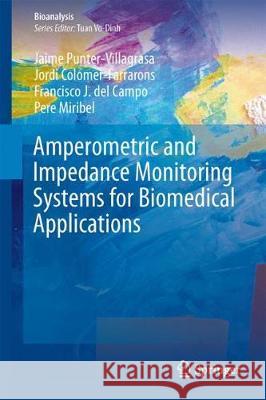Amperometric and Impedance Monitoring Systems for Biomedical Applications » książka



Amperometric and Impedance Monitoring Systems for Biomedical Applications
ISBN-13: 9783319648002 / Angielski / Twarda / 2017 / 241 str.
Amperometric and Impedance Monitoring Systems for Biomedical Applications
ISBN-13: 9783319648002 / Angielski / Twarda / 2017 / 241 str.
(netto: 384,26 VAT: 5%)
Najniższa cena z 30 dni: 385,52
ok. 22 dni roboczych.
Darmowa dostawa!
Acknowledgements. Abstract. Abbreviations. Contents. List Of Figures.
1 Introduction.
1.1 Introduction to the Point-of-Care Devices (POC). 1.2 POC Devices in the modern Healthcare system. 1.3 Focusing ON Electrochemical Devices. 1.4 Applications of the technology.
2 Electronics architectures Box.
2.1 Front-end and Back-end pervasive architecture approaches. 2.2 Front-End Electronics. The Potentiostat Amplifier. 2.3 Back-End Electronics and Data Processing. 2.4 The Lock-In Amplifier.
3 Design, Test and Validation of the proposed Architecture.
3.1 Front-End Electronics. 3.2 Back-end Electronics. 3.3 Combined Front-End and Back-end testing and validation.
4 Validation of the Pervasive Architecture with different applications.
4.1 Hematocrit (HCT) Screening Approach. 4.2 A Concentrator and Detector of Escherichia Coli.
5 New Generation of POC Device: AN Hematrocrit (HCT) Detection Case
5.1 HCT POC Devices. 5.2 System Conception and implementation. 5.3 POC validation. 5.4 HCT Screening Studies. Clinical Assessment. 5.5 Conclusions.
6 Conclusions.
Appendix A: Schematics, Design and Validation of Different Potentiostat Topologies. Appendix B: Schematics, Design and Validation of an Electronic Device for EIS Applications. Appendix C: Schematics, Design and Validation of the HCT POC Device.
Dr. Jaime Punter-Villagrasa received his BSc. degree in Electrical Engineering from University of Barcelona (UB) in 2008. From 2007 to 2008 he worked as firmware design engineer at the printing department from Hewlett-Packard Development Company. In 2010, he received his MSc. degree in Electrical Engineering from University of Barcelona (UB). In 2016 he received his PhD degree from the UB. Since 2008, he works as fellow researcher at the BioEngineering and NanoBioEngineering-SIC-BIO Group of the UB, focusing on low-voltage low-power circuits, interface circuits for biomedical applications, and microelectronic design, and since 2015 collaborates with the IMB-CNM (CSIC) within the DADDi2 project.
Dr. Jordi Colomer-Farrarons received his BSc. degree in Electrical Engineering from EUSS (Salesians Technical Engineering School) in 2002. From 2002 to 2005 he worked as hardware design engineer at the automotive company Francisco Albero SA. In 2005, he received his MSc. degree in Electrical Engineering from University of Barcelona (UB). In 2010 he received his PhD degree from the UB. Since 2009, he works as fellow researcher at the BioEngineering and NanoBioEngineering-SIC-BIO Group of the UB, focusing on low-voltage low-power circuits, smart power, harvesting circuits, interface circuits for biomedical applications, and microelectronic design. From April to July 2009, he joined the Designs Service Department at IMEC’s INVOMEC Division (Belgium). On 2011, he was with the HOLST Centre at the Eindhoven Campus (The Netherlands) and in 2014 he moves to LAAS-CNRS in Toulouse (France) as a visiting researcher. Since July 2015 he is the Biomedical Engineering Master’s Degree Coordinator (UB) and since 2016 collaborates as visiting professor with the Instituto Tecnológico de Estudios Superiores de Monterrey (ITESM-TEC) (Monterrey - Mexico).
The book presents the conception and realization of a pervasive electronic architecture for electrochemical applications, focusing on electronic instrumentation design and device development, particularly in electrochemical Point-of-Care and Lab-on-a-Chip devices, covering examples based on amperometric (DC) and impedance detection (AC) techniques. The presented electronics combine tailored front-end instrumentation and back-end data post-processing, enabling applications in different areas, and across a variety of techniques, analytes, transducers and environments.
It addresses how the electronics are designed and implemented with special interest in the flow process: starting from electronic circuits and electrochemical biosensor design to a final validation and implementation for specific applications. Similarly, other important aspects are discussed throughout the book, such as electrochemical techniques, different analytes, targets, electronics reliability and robustness. The book also describes the use of the presented electronics in different electrochemical applications through some examples: instantaneous and non-destructive cellular monitoring and portable glucose monitoring device.
Moreover, the book aims to introduce a comprehensive approach to electronic circuits, techniques and electrochemical sensors in POC devices to a general audience of students in biomedical and electronics engineering, scientists, and engineers.
1997-2025 DolnySlask.com Agencja Internetowa
KrainaKsiazek.PL - Księgarnia Internetowa









